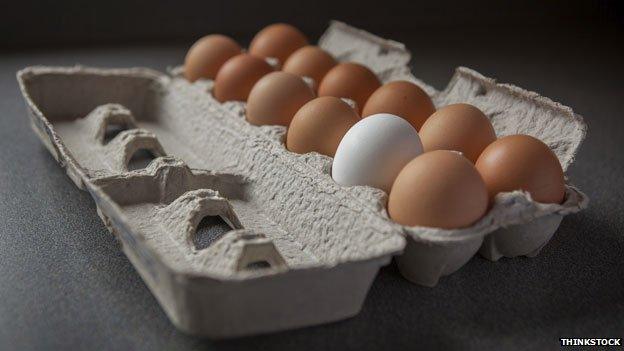In praise of the 12 times table
- Published

We still count eggs in dozens, but that's not the reason for learning the 'twelves'
Children will now have to know their 12 times tables by the age of nine, but it's not about rote learning, it's about revelling in the profusion of patterns, writes Rob Eastaway, maths writer and dad.
There was a time - several decades ago now - when the reason for learning the 12 times table was obvious. As a country using imperial measurements, we were all measuring in feet and inches and paying in shillings and pence, so multiplying by 12 was a common, everyday experience.
But for today's children this is all ancient history. Yes, we do still count eggs in dozens, and a lot of people - including most Americans - do still work in inches, but that's hardly justification for spending hours swotting those extra tables.
And yet, there's still a case for learning your "twelves", but the reason is to do with discovering patterns and building a confidence in handling numbers.
Once children begin to get comfortable multiplying numbers larger than 10, they start to get a feel for big multiplications. Knowing your 11 and 12 times tables can introduce intriguing patterns that might be missed if you stop at 10.
Much of the 11 times table is trivial to learn: 2 times 11 is 22, 8 times 11 is 88. And even when you get beyond 12, there are nice patterns to discover.
Want to multiply 11 by 23? Just take the two digits 2 and 3, add them together (makes 5) and put that number in the middle - 253. What about 36 x 11? Again, split the 3 and the 6 and put their sum (9) in the middle - 396. Lovely - though take care, if the two digits add to more than 9, this nifty trick doesn't work so neatly. 58 x 11... well 5+8 = 13, but the answer isn't 5138, that "1" actually represents a 100, and needs to be added to the 5 to give the answer 638.
There's a pattern that begins with 11 x 11, too. Multiply those two numbers together and you get 121. How about 111 x 111? The answer is 12321. Care to guess what 1111 x 1111 is? Yes, 1234321.
Meanwhile multiplying by 12 becomes much simpler when you realise it's the same as multiplying a number by 10 and then adding on double the start number. So 12 x 12 is 10 x 12 (=120) and then add 2 x 12 (=24) to give 120+24 = 144. This rule doesn't stop at your tables - 12 x 61 is the same as 10 x 61 (=610) plus 2 x 61 (=122) and if you can add 610 + 122 in your head you have the right answer, 732.
Do you need to memorise the answer to 12 x 12? Well, not really. As long as you know the strategy for working it out, you can get there almost as quickly by recalculating it in your head. But, of course, if you do a calculation often enough, it will become embedded in your memory, which will speed things up on those occasions when you need the answer.
Why stop at 12? You can continue to 13, 14… all the way up to 20 times table, as I believe happens in some countries. But hang on, if you understand your basic times tables up to 10, then you have the essential tools you need for working out, say, 19 x 14. And if you spend too much time rote learning the answers to these questions then you're going to miss out on time spent understanding how numbers work.
And it's understanding patterns and solving problems that maths is really all about.
Rob Eastaway is the co-author of Maths for Mums and Dads, external.